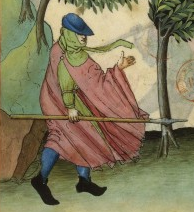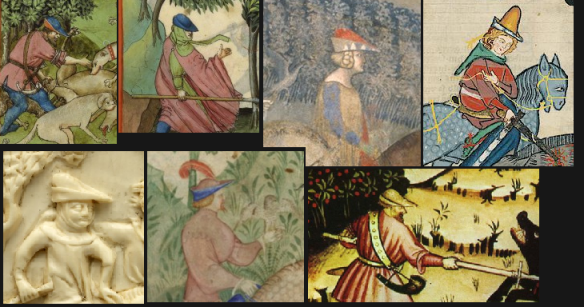A hunter clad in green, with his pointed hat jauntly cocked on his head. That is the common perception of the medieval hunter, but does it hold sway?
I used to say that “a hunter wore what was in fashion in its day”, referring to all the gaudily coloured hunters I have seen in the huntbooks in their red, blue, yellow and pink clothing. But in the same books there are also hunters wearing all green, in a way that suggests they have a reason for it – in some pictures all hunters are clad in green. But of course, hunters wear different clothes in different style of hunts…
Clothes that fit the purpose
As I look abit closer on the issue of clothing in research of this article I see that it is not really mentioned in “Master of game”. “Les Livres du roy Modus et de la royne Ratio” does not dwell on it, but in a summary of a text I find that Gaston Pheobus declares that hunters should wear green, and in winter grey.
Now, on a fastpace hunt, with dogs barking and horses running, the aim to chase the prey until exhaustion, the colours of the clothes matters little. In this case the animal is supposed to see you and run from you. Also the relays on the sides serves to herd the animal into the desired path. Clothes of colour also helps the other hunters to locate each other. One could compare it to the modern hunters orange if one likes. Most pictures in a huntbook concerns this kind of hunt.
When stalking prey and trying to get within bowrange we have a whole other situation. Here it is desirable that the deer does not see you, and hunters are advised to wear green. When standing in wait for deer driven to you, it is also advised that the hunters should wear green in “Les livres du roi Modus et de la reine Ratio”. Even Gaston Phoebus advices the use of green. Gaston Phoebus allegedly even advocates painting the bow green. When looking more closely, you see that when hunting deer, notoriously skittish animals, they usually wear green. Edward of Norwich also advocates that the best hunting horns is waxed green. He say this is for the better sound in them, but as he has misunderstood a couple of things in his translation of Gaston Phoebus, he might also have missed the point of why they where green.
Camouflage
As seen above the reason to wear green is to melt into the woods better, or at least to be less visible to the animals. But did the medieval hunter use camouflage? As in camouflage in a modern sense?
Well, yes, and no.
The use of green is a camouflage in it self, it melts into the environment. Also Phoebus stated that, when hunting a boar in winter, grey, not green, was to be worn. But there is no proof of use of mottled or patterned clothing in order to break up silhouettes. There might be some use of dagges to look more….. bushy. (“Dagges” are decoratively cut hemlines, in shapes of tounges, leafes, roundels, points and so on). At the least in ‘Livre de chasse’ there is alot of dagged open garments, but this might also just reflect the fashion of the time.
The use of branches and greenery is advised though.”Les livres du roi Modus et de la reine Ratio” advices you to ‘Wear a branch between your teeth to hide your face” when stalking deer. The use of branches on a wagon to hide its occupants is a clever trick from King Modus, and it appears in “Livre de chasse” also. As seen to the right, evidently one could cammouflage your head in such way to
Shoes, and the lack thereof
Hunters are shown wearing a variety of shoes. The ankle-high being in prominent use. Most show no buckles.
Many riders sports a high boot. They seem to be of the fold closure sort and fastened with hooks and eyelets. These are very good in protecting the leg from burrs and twigs catching in the hose and ripping them while chasing through the woods. They appear to be above the knee.
Some high boots from “Livre de chasse”
Even hunters afoot could use this, judging from these pictures in “Livre de chasse“, Sporting a leash hanging on his horn and therefore one of the berners, doghandlers. The second shows a rider and a lymer, a doghandler handling the scenthound. The third showing a regular venator, hunter. There are several more pictures of high boots in the book.
Another thing that seems prominent amongst hunters are the habit of using no shoes. Strikingly often we see hunters plodding along in just hosen. This happy fellow seems to be out and about in just his naalbound socks.
There is a possibility that they are using ‘soled hoses’, hosen with a leather sole on, but there is no way of really knowing. I have used soled hoses and I have been walking around in hoses with ordinary soles. I can say that soled hoses works rather well in a dry forest. Regular hoses is very dependant on what kind of wool they are made off, but in general they do tend to make you abit more vulnerable to pebbles and pinecones.
a few of all the pictures of hunters not using shoes
There is no reason stated in the huntbooks or anywhere else that I have seen, as to why they scamper about shoeless. My own experience shows that it a little easier to sneak in hosen as you get more ground-feeling. Possibly you also get abit more grip with a wool soles then you get with a leather one. especially in wet grass. These are mostly speculations.
Of course, there are pictures of non-hunters not wearing shoes also, but looking at the average, it sure looks like hunters liked being shoeless for some reason.
The bycocket, a hat for a hunter?
The robinhood hat, hunters cap or as we jokingly call it the “unicorn” (threepointed hat=tricorn, twopointed=bicorn… onepointed=unicorn) is possibly called a ‘bycocket’ during 14:th Century (or they mean something totally different…. the sources are abit shady here).
This hat seems to be favoured by hunters. Its is featured on them frequently in 14:th Century. It is also a hat that seems to be used by both men and woman, possibly this strengthens its position as associated with the hunt and not gender (few other head wear is not gendercoded). When seen on other nobles in outside hunt situations it is a theory I have that these are fellows that has their interest in hunting as personifying their character. As some hunters these days wear their camouflage and old hat to the supermarket to show that they hunt. But this is only my personal musings on the subject.
There is no bad weather
In Sweden we say “there is no bad weather, only bad clothing”.
Now and then the question about bad weather clothing, and especially rain clothes comes up in the reenacting community. Even though this might not fit in this post, I thought I would address it here, in wait for a post later on on how to  reenact outdoorsy type things.
reenact outdoorsy type things.
In medieval times they don’t seem to have the same obsession about being dry all the time. One can perhaps understand this as being dry is an utopia when being active in the woods. If you don’t get wet from the outside, marshes, dew, rain or moss, you get wet from the inside (commonly known as sweating). One might Think that they had a mindset that tolerated a higher degree of uncomfort before they started feeling downcast. Living a life where starvation, plague, and untimely death was never far away, a little wet was possibly not much to be concerned about. As a rule people are not made out of salt and hence do not dissolve from water.
What is problematic when getting wet is getting cold. Its the cold that is dangerous and what makes up most of the discomfort. Wool is naturally fat unless it is washed. If it is also fullered it withstands rain quite well. Wool is also a material that warms even when wet (as opposed to cotton that cools 150 times better when wet). Using wool clothing and keeping away from cotton undergarments (I usually keep away from linen as well, going all wool) will keep you warm even when wet.
The most common garment for protection against the weather is therefore …. Another tunic, possibly fullered
In conclusion, and some speculations
As I already had a nagging feeling would be the case, I was both right and wrong. Hunters did dress as fashion dictated, but there where several times where green was the preferred colour. There is also nothing stating you can not wear green on other hunts so I am guessing that many wore their ‘hunting clothes’ on hunts, and that these often where green , as they where supposed to be that on some of the more popular hunts. Also, green is not all that common amongst other people. Sure it exists, but it is not THAT popular if one looks at its percentual representation with other colours. It might surely be that green was a colour connected with hunters. In Canterbury tales the yeoman is described as having a hood and jacket of green, and that he was indeed a woodsman. This also could point towards the colour green being connected to people of the woods.
So… a hunter in green, with his bycocket jauntly on his head. Yes. It is not a faulty perception of the medieval hunter. Sometimes the middleages are so cliché.  /Johan
/Johan








